◄ Carnets Geol. 16 (7) ►
Contents
[Introduction]
[Material studied]
[Discussion] [Systematics (B.G.)]
[Age of the stratum typicum]
[The Brazilian morphotypes]
[Conclusions]
[Bibliographic references] [Table]
and ... [Plates]
"Cátedra Franco-Brasileira no Estado de São Paulo 2015", UNESP - Universidade Estadual Paulista, Center for
Geosciences Applied to Petroleum (UNESPetro), Caixa Postal 178, Av. 24 A, no. 1515, Bela Vista, CEP13506-900 - Rio
Claro - SP (Brazil)
Dépt. STU, Fac. Sci. Tech., UBO, CS 93837, F-29238 Brest (France)
Department of Ecology and Evolutionary Biology, The University of Kansas, 1200 Sunnyside
Avenue, Lawrence, Kansas 66045 (USA)
UNESP - Universidade Estadual Paulista, Center for
Geosciences Applied to Petroleum (UNESPetro) & Departamento de Geologia
Aplicada, Caixa Postal 178, Av. 24 A, no. 1515, Bela Vista, CEP13506-900 - Rio
Claro - SP (Brazil)
Published online in final form (pdf) on April 14, 2016
[Editor:
Michel ; technical editor: Bruno ;
language editor: Phil ]
A review of eight lookalike fossil species led to their being synonymized. Although Marinella lugeoni , 1939, is not the senior synonym, it is proposed to ascribe it the status of a "nomen conservandum". The age of its type-locality in Spain is Late Jurassic, not Early Jurassic. We also document small Marinella lumps found in Albian-Cenomanian strata of Brazil.
Rhodogorgonales; Elianellaceae; Solenoporacea; Marinella.
B. & D. (2016).- On the fossil alga Marinella lugeoni , 1939, nom. cons., and its seven unfortunate avatars. Revision of the Juliette Collection. Part 2. Revision of the Jesse Harlan Collection. Part 2.- Carnets Geol., Madrid, vol. 16, no. 7, p. 231-245.
À propos de l'algue fossile Marinella lugeoni , 1939, nom. cons., et ses septs avatars malheureux. Révision de la Collection Juliette . 2e partie. Révision de la Collection Jesse Harlan . 2e partie.- Le réexamen de huit espèces fossiles très semblables se conclut sur leur mise en synonymie. Bien que Marinella lugeoni , 1939, ne soit pas le synonyme senior, nous proposons de lui attribuer le statut de "nomen conservandum". L'âge de sa localité-type en Espagne est Jurassique supérieur et non Jurassique inférieur. Enfin, nous consignons la découverte de petits nodules à Marinella dans des couches albo-cénomaniennes du Brésil.
Rhodogorgonales ; Elianellaceae ; Solenoporacea ; Marinella.
Marinella lugeoni , 1939, is a fossil "calcareous alga" familiar to those people working on Upper Jurassic and Lower-"middle" Cretaceous limestones. It is not our intention to duplicate here the observations of earlier researchers on this nodular, sometimes encrusting alga, and it is particularly not our intention to duplicate the detailed information published by and del (1984), supplemented by and (1993), but we intend to present a summary of our understanding of the delimitation of this species: seven authors contributed to introduce one genus and eight species that were all synonymized ( contributed twice). Marinella lugeoni was first found in Albian-Cenomanian strata of South Atlantic marginal basins in Angola (, 1916), and later in Brazil (, 1937), before (1939) reported its occurrence in Jurassic strata from Spain. To complete this study, we reexamine the age of its stratum typicum in Spain and describe a particular morphotype commonly found in our Brazilian material.
The first author (B.G.) examined material from the Juliette Collection in Paris, from the Jesse Harlan Collection in Washington D.C. and from the UNESPetro Collection in Rio Claro (São Paulo).
When
revising the type-material of Marinella lugeoni ,
1939,
hosted at the "Laboratoire de Micropaléontologie" of the
"Université Pierre et Marie " (Paris, France),
and del (1984) had the opportunity to
examine four thin sections, "probably those used by for
the diagnosis of the genus" (the first author found only three of them),
and ten additional thin sections "made in 1967" (the first author
found only eight of them). In the meantime, some material (four thin sections)
was lost (!). The eleven remaining thin sections
(Fig. 1 ![]() ) will be relocated
and deposited with a "PC" label at the "Herbier Cryptogamique,
Département Systématique et Évolution, Muséum National d'Histoire
Naturelle" (Paris, France) with the rest of the Juliette
Collection. Two rock samples (Pl. 1
) will be relocated
and deposited with a "PC" label at the "Herbier Cryptogamique,
Département Systématique et Évolution, Muséum National d'Histoire
Naturelle" (Paris, France) with the rest of the Juliette
Collection. Two rock samples (Pl. 1 ![]() ) complete this partial inventory.
) complete this partial inventory.
With
respect to 's material, hosted by the Smithsonian Institution,
the first author managed to locate four key thin sections
(Fig. 2 ![]() ) with USNM
registration numbers D992-a-843 and D992-a-844 (,
1961), 42547 (
& , 1965) and 42606 (,
1968), but not a fifth
one with the USNM number 42467 (, 1965).
) with USNM
registration numbers D992-a-843 and D992-a-844 (,
1961), 42547 (
& , 1965) and 42606 (,
1968), but not a fifth
one with the USNM number 42467 (, 1965).
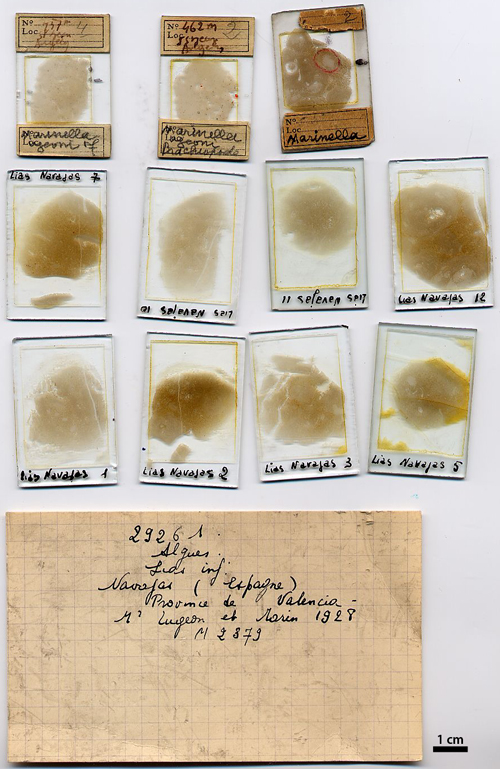
Click on thumbnail to enlarge the image.
Figure 1:
The 11 thin
sections remaining of the Juliette Collection. The lectotype
(defined here: Fig. 4 ![]() ; ,
1939, Pl. II, fig. 1) is in the last
thin section (the third from the left) of the first row. [All photos with 1 cm
scale bar]
; ,
1939, Pl. II, fig. 1) is in the last
thin section (the third from the left) of the first row. [All photos with 1 cm
scale bar]
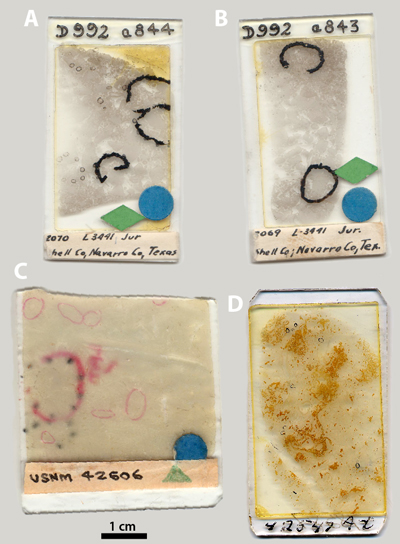
Click on thumbnail to enlarge the image.
Figure 2:
The 4 thin
sections of the Jesse Harlan Collection:
A)
D992 a844 / 2070 L 3441 Jur / Shell Co, Navarro Co, Texas;
B)
D992 a843 / 2069 L-3441 Jur. / Shell Co; Navarro Co, Tex.;
A-B)
both with Marinella lugeoni according to ,
1961;
C)
USNM 42606 with a Lithophyllum ? sp. or a Lithothamnium ? sp.
according to , 1968;
D)
USNM 42547 A-D with the type of Lithothamnium ? primitiva
& , 1965. [All photos with 1 cm scale bar]
It is easy today (half a century later) to blame the pioneers in paleophycology for their lack of scientific rigor. For instance:
(1959, p. 220 & 222) said "Lithothamnium angolense (1916) from the African Albian is also to be compared" to it, but he did not;
& (1965) described Lithothamnium ? primitiva
n. sp. (op. cit., p. 30-31, Pl. 6, fig. 1) from the same slide,
USNM no. 42547 (Slide 18587: Fig. 2 ![]() ), from which
they illustrated Marinella lugeoni
on the same plate (op. cit., Pl. 6, fig. 2) and Girvanella minuta on another plate (op. cit., Pl. 30,
fig. 1). See Fig. 3
), from which
they illustrated Marinella lugeoni
on the same plate (op. cit., Pl. 6, fig. 2) and Girvanella minuta on another plate (op. cit., Pl. 30,
fig. 1). See Fig. 3 ![]() ;
;
when (1965) described Lithothamnium ? venezuelaensis n. sp. (op. cit., p. 719, Pl. 89, figs. 1-3) from the slide USNM no. 42467 (not found), he only mentioned that "this species closely resembles 's (1959, p. 220) Lithophyllum ? shebae", but he did not push further his investigation.
However, knowledge on modern and fossil red algae has significantly grown since that time. In addition, access to information is getting easier.
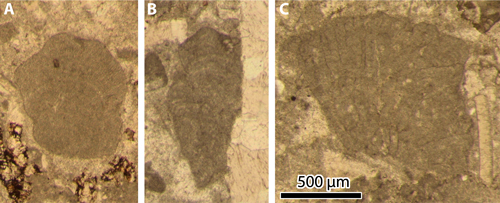
Click on thumbnail to enlarge the image.
Figure
3: Marinella
lugeoni in thin
section USNM no. 42547 of the Jesse Harlan Collection as:
A) Lithothamnium ? primitiva n. sp. ( & ,
1965, Pl. 6, fig. 1);
B) Marinella lugeoni (op.
cit., Pl. 6, fig. 2);
C) Girvanella minuta (op. cit., Pl. 30, fig. 1). [All
photos with 500 µm scale bar]
Early paleophycologists studying calcareous red algae and related forms were commonly relying on the external morphology and related features (measurements) to discriminate species. However, modern studies on the living and fossil forms ( et al., 1993) have clearly demonstrated that these characters are unreliable due to the overlaps observed between discrete species and to the wide range of variation recorded within a single species.
Another set of key parameters used to split species apart consisted of measurements: the width and height of the thallus, as well as the diameter of the "branches" (all three of which are connected to morphology and therefore irrelevant for taxonomy), the height of cell rows or of the zones comprised between successive constrictions and the diameter of the filaments. Should we plot on a graph the last two parameters for the eight species, we would get a figure with overlapping clusters. For instance, according to (1939), the filament diameters and the zone heights are respectively 6-9 and 25-40 µm in her species whereas, according to & del (1984), they are respectively 2-10 and 20-40 in Marinella yugoslavica , 1962 (a nomen nudum).
In conclusion, these eight species should be synonymized because external morphology and related features (measurements) cannot be used ( et al., 1993) and because the remaining measurements (zone heights and filament diameters) fail to differentiate species from each others.
Marinella lugeoni is ascribed to the Family Elianellaceae in & , 2016 (in replacement of the Family Solenoporaceae , 1927), that groups those extinct "calcareous algae" sharing some morphological features:
A) they are either encrusting or form free structures;
B) they have a framework made of erected filaments, more or less densely juxtaposed, with common to rare horizontal partitions (i.e., they are pluricellular algae), defining a more or less preserved lattice-network with columns and rows. Horizontal partitions have been documented in Marinella by & del (1984), & (1993), and (1994);
C) their mineralization is intracellular, centripetal (starting from the cell walls inwards), and consists of elongated fibrous calcite (probably high-Mg calcite) crystals, another feature that justifies their ascription to the calcifying red algae;
D) they are deprived of fossilized reproductive organs (which were possibly external). The "sporangia" reported by (1970) or & (1993) in Marinella are probably microborings sensu (2014), which was the conclusion of & del (1984).
This family was tentatively assigned to the Order Rhodogorgonales & , 1995, a sister group to the Sporolithales ( & , 2016).
Division Rhodophyta
Class Florideophyceae , 1960
Subclass Corallinophycidae & , 2007
Order ? Rhodogorgonales & , 1995
Family Elianellaceae in & , 2016
(formerly Family Solenoporaceae , 1927)
Genus Marinella , 1939
Type: Marinella lugeoni ,
1939, p. 215-216, Pl. II, figs. 1-2.
Lectotype (defined here): Fig. 4 ![]() ; ,
1939, Pl. II, fig. 1.
; ,
1939, Pl. II, fig. 1.
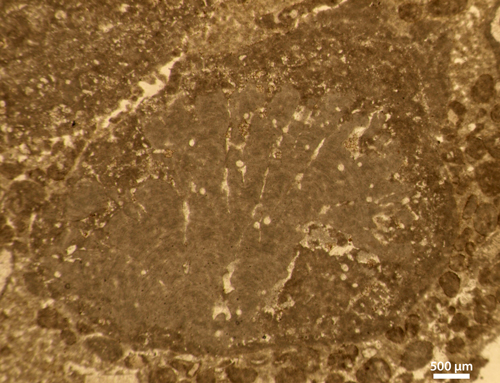
Click on thumbnail to enlarge the image.
Figure 4: Lectotype (defined here) of Marinella lugeoni , 1939 (op. cit., Pl. II, fig. 1). Small rounded structures up to 100 µm in diameter are microborings. Thin section of the Juliette Collection with labels "2" and "Marinella". [Scale bar 500 µm]
Marinella lugeoni , 1939, nomen conservandum
(Figs. 3.A-C ![]() ,
4
,
4 ![]() ,
5.A-C
,
5.A-C ![]() ,
6
,
6 ![]() ,
7
,
7 ![]() ,
8
,
8 ![]() ,
9
,
9 ![]() ;
Pl. 2
;
Pl. 2 ![]() , figs. A-K)
, figs. A-K)
Synonymy list (not exhaustive):
|
Lithothamnion angolense n. sp.- , p. 582-583, Pl.,
figs. 2 [here Fig. 5.A |
||
|
non |
Lithothamnion angolense n. sp., "conceptacles".- , p. 582-583, Pl., figs. 5-6 |
|
|
1928 |
Lithothamnium (?) sp.- & , p. 150-151, Pl. XIX, fig. 5 pars |
|
|
Lithothamnium ? regonis n. sp.- in , p. 45, Pl. XXVII, figs. 2-4; Pl. XXVIII, figs. 2-3 |
||
|
Marinella lugeoni nov. gen. nov. sp.- ,
p. 215-216, Pl. I,
fig. 1 pars; Pl. II, figs. 1-2 |
||
|
Lithophyllum (?) shebae sp. nov.- , p. 220 & 222, Pl. 1, fig. 7 |
||
|
Marinella lugeoni.- , p. 147-148, Pl. 31,
figs. 1 [here Fig. 6 |
||
|
nom. nud. |
Archaeolithothamnium
somensis n. sp.- , p. 56, Pl. 3, figs. 1-2;
Pl. 4, figs. 1-4; Pl. 17, fig. 1 [Note: according to its
author, the "Holotype" consists of the "Slide no. 675"
with two figures (Pl. 4, figs. 2-3) assigned to it] |
|
|
nom. nud. |
Marinella
yugoslavica sp. nov.- , p. 189-192, Fig. 127.a-e;
Pl. XXXIV, figs. 1-5 [Note: according to its author, the holotype is
the (?) sample "no. A 1"; the figures consist of a rock sample (x2),
three specimens in thin section (x10) and an enlargement (x200)] |
|
|
Marinella lugeoni.- , p. 25, Pl. 2, fig. 10; Pl. 23, figs. 1 (excerpt from , 1939, Pl. II, fig. 2) & 3 (excerpt from , 1939, Pl. II, fig. 1) |
||
|
Marinella lugeoni.- , Pl. 23, fig. 2 pars (excerpt from , 1939, Pl. I, fig. 1) |
||
|
Archaeolithothamnium somensis.- , Pl. 40, figs. 1 (excerpt from , 1961, Pl. 3, fig. 1) & 2 (excerpt from , 1961, Pl. 3, fig. 2) |
||
|
nom. nud. |
Lithothamnium
? venezuelaensis n. sp.- , p. 719, Pl. 89, figs.
1-3 [Note: according to its author, the figures correspond to "cotypic
sections"] |
|
|
Marinella lugeoni.- , p. 57-60, Pl. 11, figs. 7-17; Pl. 12, figs. 1-9; Pl. 13, figs. 1 (excerpt from , 1964, Pl. 2, fig. 10) & 2-4; Pl. 14, figs. 1-2 |
||
|
Lithothamnium ? primitiva n. sp.- & ,
p. 30-31, Pl. 6, fig. 1 [here Fig. 3.A |
||
|
Marinella lugeoni.- & , p. 74,
Pl. 6, fig. 2 [here Fig. 3.B |
||
|
Girvanella minuta.- & , p. 96,
Pl. 30, fig. 1 [here Fig. 3.C |
||
|
Lithothamnium ? sp.- , p. 7 |
||
|
Lithophyllum ? sp.- , Pl. 1, fig. 1 [here
Fig. 8 |
||
|
Marinella lugeoni.- & , p. 218-219, Pl. 1, figs. 7-9 |
||
|
Lithothamnium ? primitiva.- , p. 11, Pl. 3,
fig. 1 = Pl. 4, fig. 1 (excerpt from
& , 1965, Pl. 6, fig. 2 [here Fig. 3.B |
||
|
Lithothamnium (?) shebae.- , p. 11, Pl. 3, fig. 1 (excerpt from , 1959, Pl. 1, fig. 7) |
||
|
Marinella lugeoni.- , p. 34, Pl. 4, fig. 2 (excerpt from
& ,
1965, Pl. 6, fig. 2 [here Fig. 3.B |
||
|
nom. nud. |
Lithothamnium ? venezuelaensis.- , p. 13, Pl. 5, figs. 1 (excerpt from , 1965, Pl. 89, fig. 2), 2 (excerpt from , 1965, Pl. 89, fig. 1) & 3 (excerpt from , 1965, Pl. 89, fig. 3) |
|
|
Marinella lugeoni.- , p. 82-84, Photos 8-9 |
||
|
Lithophyllum (?) shebae.- & , p. 426 & 428, Pl. 7, figs. 1-2 |
||
|
Marinella lugeoni.- & , Pl. 4, fig. 5 |
||
|
Marinella lugeoni.- & del , p. 205-207 & 212-214, Fig. 1; Pl. I, figs. 1-2; Pl. II, figs. 1-2 |
||
|
nom. nud. |
Marinella yugoslavica.- & del , p. 207-208 & 215-223, Figs. 3-6; Pl. III, figs. 1-5; Pl. IV, figs. 1-2; Pl. V, figs. 1-2; Pl. VI, figs. 1-4; Pl. VII, figs. 1-2; Pl. VIII, figs. 1-3; Pl. IX, figs. 1-4; Pl. X, fig. 1 |
|
|
nom. nud. |
? 1984 |
Marinella yugoslavica.- & del , p. 224-225, Pl. XI, figs. 1-3; Pl. XII, figs. 1-2; Pl. XIII, figs. 1-3 |
|
Marinella lugeoni.- , p. 266, Pl. 49, figs. a-d & f |
||
|
Lithothamnium angolense.- et al., p. 173-175, Pl. 3, fig. 2 |
||
|
Marinella lugeoni.- et al., p. 175, Pl. 5, fig. 8 pars |
||
|
Marinella lugeoni.- , p. 47, Pl. 16, figs. 6-7 |
||
|
Marinella lugeoni.- & , p. 107-116, Pl. 1, figs. 1-4 pars, 5, 6-7 pars & 8-10; Pl. 2, figs. 1-12; Pl. 3, figs. 1-2 pars & 3-9 |
||
|
Marinella lugeoni.- , p. 162, Pl. XIX, figs. 9-12 |
||
|
non |
Lithothamnion angolense.- et al., p. 91, Fig. 8 |
|
|
Marinella lugeoni.- et al., p. 175, Pl. 2, fig. 1 |
||
|
Marinella lugeoni.- et al., p. 527, Pl. 9 |
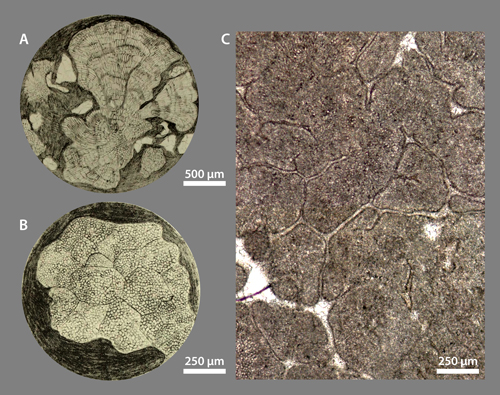
Click on thumbnail to enlarge the image.
Figure 5: A-B) Lithothamnion angolense , 1916; A) "Longitudinal section of 290" (excerpt from , 1916, Pl., fig. 2); B) "Transverse section of 290, showing lines produced by compression, due to growth" (excerpt from , 1916, Pl., fig. 4). It is the lectotype defined here; C) transverse section of Marinella lugeoni , 1939, for comparison. Thin section UPAFSE 149, locality SE 6, Sergipe, Brazil; Albian, Riachuelo Formation (enlarged view of Pl. 9, up right figure in , 2015). [A) scale bar 500 µm; B-C) scale bar 250 µm]
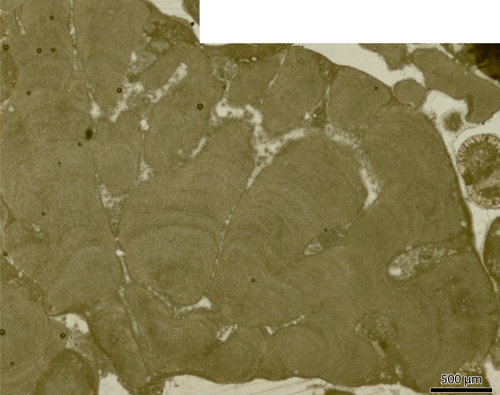
Click on thumbnail to enlarge the image.
Figure 6: Marinella lugeoni in thin section USNM no. D992 a843 of the Jesse Harlan Collection (, 1961, Pl. 31, fig. 1). [Scale bar 500 µm]
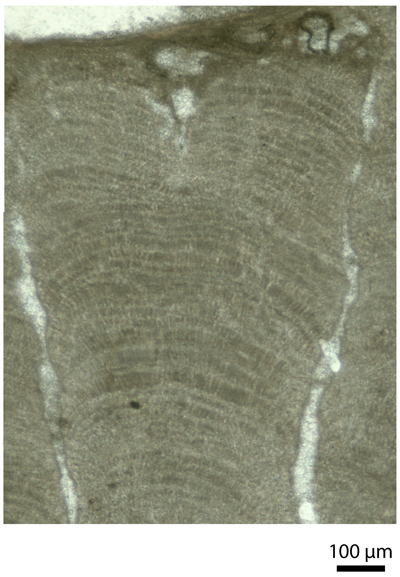
Click on thumbnail to enlarge the image.
Figure 7: Marinella lugeoni in thin section USNM no. D992 a844 of the Jesse Harlan Collection (, 1961, Pl. 31, fig. 2). [Scale bar 100 µm]
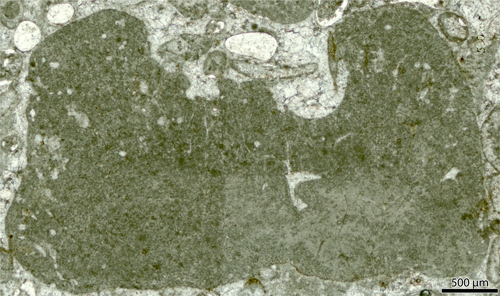
Click on thumbnail to enlarge the image.
Figure 8: Marinella lugeoni in thin section USNM no. 42606 of the Jesse Harlan Collection as Lithophyllum ? sp. (, 1968, Pl. 6, fig. 1). [Scale bar 500 µm]
Taxonomic note: Considering the International Code of Nomenclature for algae, fungi, and plants ( et al., 2012), Lithothamnion angolense , 1916, or Lithothamnium ? regonis in , 1937, have priority [cf. Art. 11 of the ICBN] over Marinella lugeoni , 1939. However, the use of the last name is by far the most common and it is permanently attached (the nomenclatural type) to the genus Marinella , 1939, the validity of which is established beyond doubt; on the other hand, the first two names were correctly used only once, in their original descriptions (remark: the Lithothamnion angolense quoted by et al., 2007, refers to a discrete species, i.e., a genuine Lithothamnion species, but not the Angolan form). For these reasons and for stability of the nomenclature, as in et al. (1991) earlier, the first author (B.G.) proposes to conserve the name Marinella lugeoni , 1939.
Description: Except for an additional remark on the occurrence of cross partitions within the filaments, there is no need to alter the original description (, 1939, p. 215-216):
"Il s'agit probablement d'une algue filamenteuse, (...) zonée, genre 'bouffée de pipe' de H. (…). Le thalle est formé par des filaments juxtaposés, sans cloisons*, mais avec des constrictions ; ils changent de direction fréquemment, tout en restant rayonnants, jamais pelotonnés. Le tissu forme un chevelu plutôt qu'un réseau. L'ensemble constitue un thalle digité, cranté, en éventail, d'aspect sombre, car le diamètre des filaments tubuleux est très petit, 6 à 9 µ généralement (pl. II, fig. 1). Les constrictions, dans les filaments, sont souvent à un même niveau et forment des lignes concentriques sur le thalle (pl. II, fig. 2). La section transversale des tubes, juxtaposés, est polygonale ou arrondie et semble de dimension un peu variable ; 9 µ de diamètre généralement. Ces thalles sont aisément reconnaissables, dans les préparations, où ils paraissent plus sombres, étant formés d'un tissu plus serré, plus régulier, et non orientés concentriquement comme les filaments des Girvanelles."
["It is probably a filamentous alga, (...) zoned with the H. 's 'puff of pipe smoke' type (…). The thallus consists of juxtaposed filaments, without cross partitions [*], but with constrictions; they frequently vary in direction, while remaining radiating, never curled up. The fabric looks hairy rather than forming a lattice. The whole thing forms a finger thallus, notched, fan-shaped, dark, because the diameter of the tube-like filaments tubuleux is very small, usually 6 to 9 µ (Pl. II, fig. 1). The constrictions within the filaments are often at the same level and form concentric lines on the thallus (Pl. II, fig. 2). Transverse sections of juxtaposed tubes are either polygonal or rounded and apparently may slightly vary in size; with a diameter of 9 µ in average. These thalli are readily identifiable in the thin sections where they appear darker, being formed of a denser, more regular fabric, which is not concentrically oriented like the Girvanella filaments."]
Finally, as pointed out by our predecessors (e.g., , 1965; & , 1965; & del , 1984, inter alia), one should add that there is "no evidence of reproductive structures".
According
to (in , 1939, p. 213), the stratum typicum should
correspond to the lower Liassic (lowermost Jurassic). However that was not the
opinion of (1943, p. 9) who stated: "Recientemente M.lle
(...) ha descrito unas algas nuevas procedentes de Navajas
(Castellón de la Plana) y que según y A. , que las
recogíeron, pertenecen al Liasico inferior sin mas precisión de nivel: por
el aspecto de la roca simplemente, pues no hemos explorado nunca esta zona,
hubiéramos creído tratarse del Jurásico superior, pues el Liasico tiene aquí
poco desarrollo en comparación con el que se encuentra más al Norte,
especialmente en la provincia de Teruel" [Recently Miss
(...) described some new algae from Navajas (Castellón de la Plana) and that
according to and A. , who collected them,
belong to lower Liassic strata without further precision on the level: simply
on the basis of the aspect of the rock, because we have never explored this
area, we would have believed it to be Upper Jurassic, because the Liassic in
this region is very
little developed compared with that which is found farther northwards,
especially in the Province of Teruel]. In the notice of the Mapa
geologico de España for Jerica (, 1977), the strata
bearing Marinella, together with Alveosepta jaccardi (,
1894), are given a Middle-Late Kimmeridgian age. The latest foraminifer, which
is a marker for the Upper Oxfordian - Kimmeridgian interval, is present in our
set of thin sections (Fig. 9.A-E & G-H ![]() ).
(1939) probably
misidentified it as "très petites Choffatella "
["very small Choffatella "].
).
(1939) probably
misidentified it as "très petites Choffatella "
["very small Choffatella "].

Click on thumbnail to enlarge the image.
Figure 9: A-E & G-H) Alveosepta jaccardi (, 1894); F) Nautiloculina oolithica , 1938. Thin sections: A) Navajas 12, B) Navajas 11, C-E) Navajas 7, F) Navajas 3, G-H) Navajas 5, Juliette Collection. [All photos with 250 µm scale bar]
In
some thin sections from the Albian limestones of the Riachuelo Formation
(Sergipe basin, Brazil), we identified two type of grains or structures with Marinella:
1) Marinella is a main contributor to some biolithites (framestones)
and rhodolithes, commonly asymmetrical, 2) Marinella is also found in
the form of small lumps, rarely exceeding 1 mm in diameter. The characteristic
feature of these Marinella lumps is to have a hollow structure (filled
by a late drusy calcitic cement), subcircular (Pl. 2 ![]() , figs. B-F & I-K; ,
2015, Pl. 9, down left figure) to
ovoid (Pl. 2
, figs. B-F & I-K; ,
2015, Pl. 9, down left figure) to
ovoid (Pl. 2 ![]() , fig. G) in section, and eventually elongated and rounded on one end
and open on the opposite end (Pl. 2
, fig. G) in section, and eventually elongated and rounded on one end
and open on the opposite end (Pl. 2 ![]() , figs. A & H). This hole is not a
sporangia nor a microboring (see discussion on "empty sporangial complexes
versus trace fossils" in et
al., 2014). It is located in the core of the lump and at the base of the Marinella
filaments. Such cylindrical holes (with a maximum diameter of
300 µm) probably represent moulds of parts of larger organisms that did not
fossilize, such as the stipes of non-calcifying brown, green or red algae or
of seagrasses, upon which Marinella was growing. When these organisms died,
lumps were freed like the pearls of a broken necklace.
, figs. A & H). This hole is not a
sporangia nor a microboring (see discussion on "empty sporangial complexes
versus trace fossils" in et
al., 2014). It is located in the core of the lump and at the base of the Marinella
filaments. Such cylindrical holes (with a maximum diameter of
300 µm) probably represent moulds of parts of larger organisms that did not
fossilize, such as the stipes of non-calcifying brown, green or red algae or
of seagrasses, upon which Marinella was growing. When these organisms died,
lumps were freed like the pearls of a broken necklace.
This study of Marinella specimens, which include type-materials from Juliette and Jesse Harlan collections, helped us to sort out some of the details pertaining to the alga systematics, its stratigraphy and its paleoenvironments:
Marinella lugeoni , 1939, is not the senior synonym out of eight taxa listed above, but it is proposed in order to conserve the specific epithet lugeoni, as it is attached to the generic name Marinella;
its stratum typicum in Spain is not Liassic (Early Jurassic) in age but Malm (Late Jurassic), more specifically Kimmeridgian, in age;
the common occurrence of characteristic small Marinella lumps documents its epithital behaviour and could be used as a paleoenvironmental criterion to identify ancient seagrass and seaweed meadows.
This publication follows the "Revision of the Juliette Collection - Part 1" ( & , 2016) and the "Revision of the Jesse Harlan Collection - Part 1" ( et al., 2013). In 2015, the first author (B.G.) was the laureate of a Franco-Brazilian professorship at the UNESPetro in Rio Claro (São Paulo State, Brazil) that enabled him to work on Brazilian material. Earlier, in 2012, he also benefited from a Smithsonian Fellowship allowing him to investigate the J. Harlan Collection stored in the premises of the Smithsonian Institution. He would like to thank the staff of the Department of Paleobiology at the Smithsonian National Museum of Natural History and particularly William A. and Jonathan G. for their hospitality and having facilitated his work there. He is also grateful for the support provided by the successive curators of paleontological collections at the Université Pierre et Marie Curie, first Jean-Pierre , then Isabelle . Special thanks to Christine , Mitsuru , Michael P.A. , and Hermès who helped with documentation. Phil helped polishing the English text. This research is associated with the "Carbonatos do Brasil Project" linked to the Brazilian Sedimentology/Stratigraphy Net sponsored by Petrobras; it was also partly sponsored by the Foundation "Carnets de Géologie".
P.W. & H.S. (1971).- Calcareous algae from the Jurassic and Cretaceous of Lebanon.- Micropaleontology, New York, vol. 17, no. 4, p. 411-433 (7 Pls.).
F. & del M.C. (1984).- Alghe rosse Solenoporacee del Cenomaniano dei dintorni di Caserta (Appennino meridionale, Italia).- Bolletino della Società dei Naturalisti in Napoli, vol. XCIII, p. 203-255 (Pls. I-XIII).
J.R. (1943).- Sobre una fauna jurasica de Valencia.- Boletim da Sociedade Geologica de Portugal, Lisboa, vol. III, p. 7-16.
P. & P.Y. (1982).- Microfossiles et échinodermes incertae sedis des dépôts albiens à coniaciens du bassin de Sergipe-Alagoas, Brésil.- Cahiers de Micropaléontologie, Paris, vol. 3, p. 13-22, 1982.
J. & R. (1968).- Les algues du Néocomien d'Aquitaine.- Bulletin du Centre de Recherche Pau - SNPA, Pau, vol. 2, no. 2, p. 213-261 (7 Pls.).
I.I. (1994).- Algues calcaires de la zone de Resita-Moldova Noua (Carpathes Méridionales, Roumanie).- Revue de Paléobiologie, Genève, vol. 13, no. 1, p. 147-209 (XXII Pls.).
G.F. (1959).- New calcareous algae from the Cretaceous of Iraq.- Revue de Micropaléontologie, vol. 1, no. 4, p. 217-222 (2 Pls.).
R. (1961).- Calcareous algae from the Jurassic Torinosu Limestone of Japan. In: Commemorative volume dedicated to Professor Riuji .- The Science Reports of the Saitama University, Urawa, (Series B, Biology and Earth Sciences), p. 53-75 (17 Pls.).
S. & J.N. (1995).- A new Order (Rhodogorgonales) and Family (Rhodogorgonaceae) of red algae composed of two tropical calciferous genera, Renouxia gen. nov. and Rhodogorgon.- Cryptogamic Botany, Stuttgart, vol. 5, p. 316-331.
J. (1970).- Calcareous algae from the Upper Jurassic of the southern periphery of the Świętokrzyskie Mts. Part I: Rhodophyta.- Bulletin de l'Académie polonaise des Sciences, Kraków, (Série des Sciences géologiques et géographiques), vol. XVIII, no. 2, p. 75-84.
B. (1987).- Le Crétacé inférieur de la Costa Blanca entre Busot et Altea, Alicante (Espagne) : biostratigraphie, sédimentologie, évolution tectono-sédimentaire.- Thèse, Docteur de l'Université Paris VI (nouveau régime); Mémoires des Sciences de la Terre, Université Pierre et Marie Curie, Paris, no. 87-49, vol. I (text): 281 p.; vol. II (plates): 54 Pls.
B. (2014).- Borings and etchings in the Upper Bathonian-Lower Callovian oolite of the Paris Basin (France).- Carnets Geol., Madrid, vol. 14, no. 21, p. 461-469.
B. (2015).- Algas calcárias marinhas bentônicas no Cretáceo do Brasil. In: D. & P. (eds.), Atlas dos Calcários do Cretáceo do Brasil: um Atlas.- IGCE/UNESP/Rio Claro, UNESPetro, Obra 1, p. 518-567.
B., P.-Y. & A.-F. (1991).- Constructions bio-sédimentaires laminées, Lithothamnium et Parachaetetes de la Formation Riachuelo (Albien) du bassin de Sergipe (Nord-Est du Brésil).- Geociências, São Paulo, vol. 10, p. 169-181 (5 Pls.).
B. & D. (2016).- On the fossil alga Elianella elegans & , 1948, and its so-called lookalikes, with description of Elianella brasiliana n.sp. Revision of the Juliette Collection. Part 1.- Carnets Geol., Madrid, vol. 16, no. 6, p. 213-229 (4 Pls.).
B., D. & I.I. (2008).- Calcareous algae from Upper Albian – Cenomanian strata of the Potiguar basin (NE Brazil).- Geologia Croatica, Zagreb, vol. 61, no. 2-3, p. 139-147 (2 Pls.).
B., R. & K. (2013).- Revision of the Jesse Harlan Collection. Part 1. Some fossil Dasycladales from Guatemala.- Carnets Geol., Madrid, vol. 13, no. A07 (CG2013_A07), p. 58 (Pl. 1), 66 (Pl. 2), 82 (Pl. 3), 88 (Pl. 4), 104 (Pl. 5), 130 (Pl. 6), 208 (Pl. 7), 280 (Pl. 8) & 281-301 (8 Pls.).
R. (1965).- Late Jurassic algae from Honshu and Shikoku, Japan.- The Science Reports of the Tohoku University, Sendai (Second Series, Geology), p. 49-62 (Pls. 9-14).
J.H. (1961).- Jurassic algae from the subsurface of the Gulf Coast.- Journal of Paleontology, vol. 35, no. 1, p. 147-151 (Pls. 31-32).
J.H. (1964).- The Jurassic algae.- Quarterly of the Colorado School of Mines, Golden, vol. 59, no. 2, xi + 129 p. (45 Pls.).
J.H. (1965).- Three Lower Cretaceous algae new to the Americas.- Journal of Paleontology, vol. 39, no. 4, p. 719-720 (Pl. 89).
J.H. (1968).- Lower Cretaceous algae from Texas.- Professional Contributions of the Colorado School of Mines, Golden, no. 4, p. vii + 71 (12 Pls.).
J.H. (1969).- A review of the Lower Cretaceous algae.- Professional Contributions of the Colorado School of Mines, Golden, no. 6, p. xvi + 180 (68 Pls.).
J.H. & H.V. (1965).- Fossil Algae from Guatemala.- Professional Contributions of the Colorado School of Mines, Golden, no. 1, xii + 152 p. (XXXVI Pls.).
R.R. & W. (1993).- Systematic position and palaeoecology of the Upper Jurassic to Tertiary alga Marinella lugeoni .- Zitteliana, Reihe B, Abhandlungen der Bayerischen Staatssammlung für Paläontologie und Geologie, München, Heft 20, p. 105-122 (3 Pls.).
J., F.R., W.R., V., W., D.L., P.S., S., K. van W.F., G.F., J.H. & N.J. (2012).- International Code of Nomenclature for algae, fungi, and plants (Melbourne Code). Regnum Vegetabile 154.- Koeltz Scientific Books, Koenigstein, xxx + 240 p. URL: http://www.iapt-taxon.org/nomen/main.php?page=title
V.P. (1962).- Ископаемые багряные водорослиСССР и их связъ с фациями.- Академии Наук СССР, Труды геологического института [Akademii Nauk SSSR, Trudy Geologieskogo Instituta], Moskva, no. 53, 222 p. (36 Pls.) [in Russian]; Algues rouges fossiles d'U.S.S.R. et leur rapport avec les faciès.- Bureau de Recherches géologiques et minières, Paris, Traduction, no. 3811, 48 p. ; no. 4382, p. 42-132 (Pls. XIII-XXXVI) [in French].
C.J. (1937).- O Cretáceo de Sergipe.- Serviço Geológico e Mineralógico do Brasil, Monographia, Rio de Janeiro, no. XI (1936), 283 p. (XXVIII Pls.).
F. (1977).- Jerica.- Mapa geologico de España, E. 1:50.000, IGME, Madrid, (2a Serie), 639, 45 p. URL: http://info.igme.es/cartografia/datos/magna50/memorias/MMagna0639.pdf & http://info.igme.es/cartografia/datos/magna50/jpg/d6_jpg/Editado_MAGNA50_639.jpg
J. (1939).- Sur un calcaire phytogène du Lias inférieur d'Espagne et l'extension de ce faciès en quelques autres régions.- Bulletin de la Société vaudoise des Sciences naturelles, vol. 60, no. 248, p. 213-228 (Pls. I-V).
J. (1927).- 1. Abteilung: Thallophyta. In: M. (ed.), Handbuch der Paläobotanik.- R. Oldenbourg, München & Berlin, p. 31-136.
R. (2004).- Solenopora is a chaetetid sponge, not an alga.- Palaeontology, vol. 47, no. 1, p. 117-122.
M.F. (1916).- XVI. Note on an algal limestone from Angola.- Transactions of the Royal Society of Edinburgh, vol. LI, part III, no. 16, p. 581-584 (Pl.).
F. (1991).- Allochtone Urgonkalke im Mittleren Abschnitt der Nördlichen Kalkalpen: Fazies, Paläontologie und Paläogeographie.- Münchner Geowissenschaftliche Abhandlungen, Reihe A Geologie und Paläontologie, 20, p. 1-120 (19 Pls.).
S., J., J.C. & C. (2007).- Late Hauterivian coralline algae (Rhodophyta, Corallinales) from the Iberian Chain (E Spain). Taxonomy and the evolution of multisporangial reproductive structures.- Facies, Erlangen, vol. 53, no. 1, p. 79-95.
W.J., B. & D. (2014).- Heydrichia (?) poignantii, sp. nov. (Sporolithaceae, Sporolithales, Rhodophyta), a 100 million year old fossil coralline red alga from north-eastern Brazil, and a new Hauterivian record of Sporolithon from Switzerland.- Carnets Geol., Madrid, vol. 14, no. 7, p. 139-158.
W.J., L.M. & A.S. (1993).- Growth-forms in non-geniculate coralline red algae (Corallinales, Rhodophyta).- Australian Systematic Botany, Clayton, vol. 6, no. 4, p. 277-293.
H. & S. (1928).- On some rock-forming algae from the younger Mesozoic of Japan.- The Science Reports of the Tohoku Imperial University, Sendai, (2nd Series, Geology), vol. 12, no. 1, p. 141-152 (Pls. XVIII-XXIII).
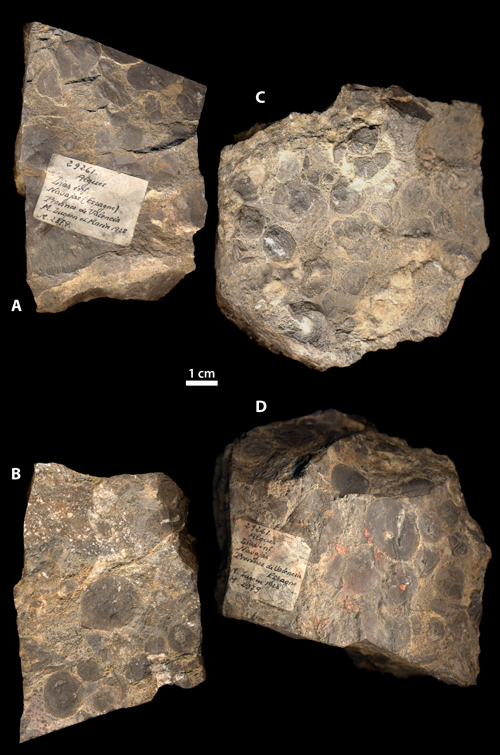
Click on thumbnail to enlarge the image.
Plate 1: Two rock samples representing the original material used to make the thin sections. Figs. A-B) label 29261 / Algues / Lias inf. / Navajas (Espagne) / Province de Valence / M. et 1928 / M. 2379. Figs. C-D) label 29261 / Algues / Lias inf. / Navajas / Province de Valence / Espagne / M. 1928 / M. 2379 ; fig. C) see , 1939, Pl. I, fig. 1. [All photos with 1 cm scale bar]
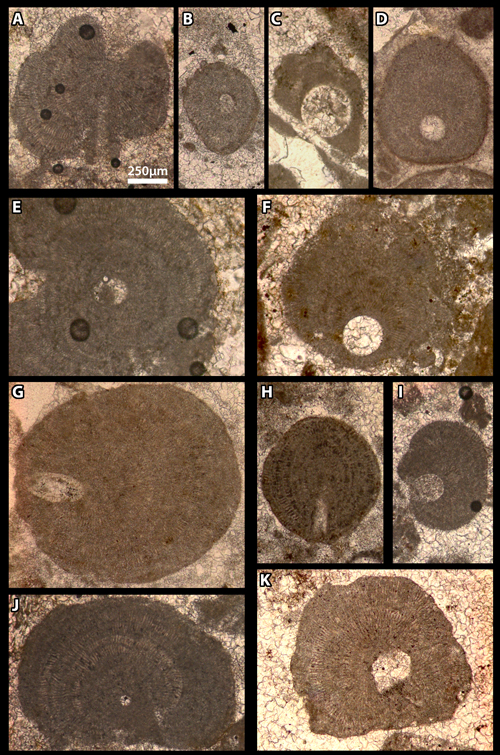
Click on thumbnail to enlarge the image.
Plate 2: Marinella lumps. Fig. A) thin section UPAFSE 117; fig. B) thin section UPAFSE 99; fig. C) thin section UPAFSE 118; fig. D) thin section UPAFSE 94; fig. E) thin section UPAFSE 117; fig. F) thin section UPAFSE 121; fig. G) thin section UPAFSE 99; fig. H) thin section UPAFSE 99; fig. I) thin section UPAFSE 108; fig. J) thin section UPAFSE 118b; fig. K) thin section UPAFSE 118. Fig. D, locality SE1, and figs. A-C and E-K, locality SE 3, Sergipe, Brazil; Albian, Riachuelo Formation. [All photos with 250 µm scale bar]